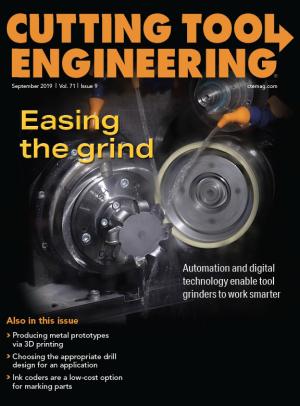The term “rapid prototyping” entered machine shop parlance in the late ’80s, not long after 3D Systems Inc.’s co-founder Chuck Hull invented stereolithography (SLA) and then opened the doors of the world’s first commercial 3D printer manufacturer. People soon began turning to SLA-equipped service bureaus for help with product development, expecting prototype parts in hours or days rather than the weeks and months to which they were accustomed.
Missing Metal
There was one problem: If you wanted prototypes made of metal, you’d best hope you were still in good graces with your local machine shop after abandoning it for some upstart service bureau. That’s because those early SLA prototypes were available only in photo-cured resin.
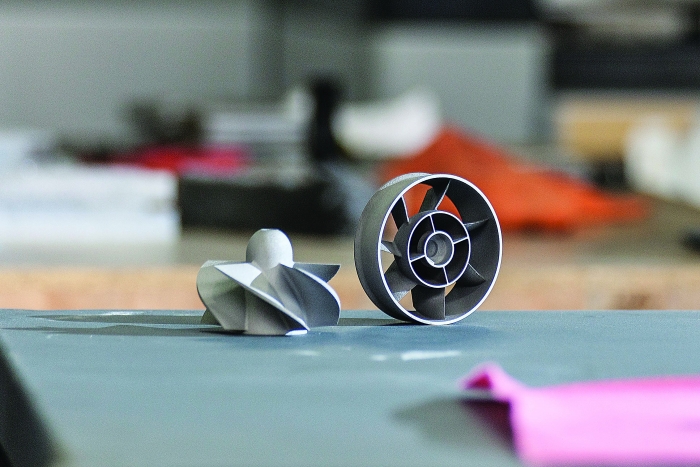
If a part contains one or more complex features or is difficult or even impossible to machine, it’s probably a good fit for 3D printing, according to Xometry. Image courtesy of Xometry
This limitation began to lift with the advent of fused deposition modeling (FDM) and selective laser sintering, both of which offer far more polymer options than SLA. What’s more, SLA quickly expanded its resin-based offering. The result was that practically any polymer became printable, including ABS, PET, nylon, polycarbonate, TPE and PEEK. Still, none of these technologies could print metal.
That’s changed over the past three decades with the development of metal powder bed 3D printing and, more recently, binder jet and metal-injection-molded-like (MIM) additive manufacturing (AM).
Jeph Ruppert, director of the Customer Innovation Center for 3D Systems, Rock Hill, South Carolina, said today’s metal powder bed printers make it possible to produce prototype and low-volume production parts from various metals, such as tool steel, titanium, stainless steel and cobalt-chrome alloy. In metallurgical terms, these 3D-printed alloys are virtually identical to their forged, cast or rolled counterparts, and the same freedom of design common with 3D-printed polymer parts is available with metal ones.
Faster, Better, More Affordable
“Thanks in large part to Chuck Hull’s invention, plastics have long been the standard material for rapid prototyping,” Ruppert said. “Prototyping in metals, however, offers several advantages. If the part you wish to produce will ultimately be made of metal, a metal prototype gives you a better representation of its form, fit and function. Also, metal parts are generally more durable than ones made of plastic, meaning they can better withstand the rigors of testing.”
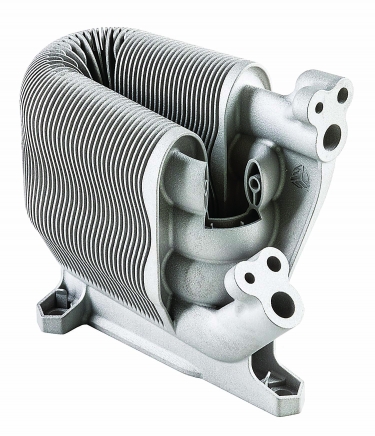
This stainless steel lamella heat exchanger was designed for restricted space in an assembly. Additive manufacturing enabled the inclusion of encapsulated conformal internal channels, as well as integrated turbulators to improve the heat transfer coefficient, and reduced the part count from 40 pieces to one. Image courtesy of 3D Systems
Ruppert said rapid prototyping with metal is becoming more accurate, affordable, functional and faster. Speed is especially beneficial in a world that demands quick turnaround on design iterations. As a result of this synergy, 3D Systems—together with competing service providers and AM equipment builders—has seen an exponential increase over the past five years in metal powder bed prototyping requests from customers in the aerospace, medical and energy industries. This trend also correlates to the increased adoption of metal AM in full-scale production.
Examples are orthopedic implants and surgical instruments, aerospace structural components and industrial gas turbine components. “Prototyping in metal also reduces the development cycle, dramatically in some cases,” Ruppert said. “Because the prototype part is so much closer to the finished, functional part, the path to market within these critical-application industries is much more direct.”
Manufacturing Accelerated
Maple Plain, Minnesota-based Proto Labs Inc., which does business as Protolabs, does not build 3D printers—metal or otherwise—but sure uses a lot of them. Joe Cretella, application engineer at Protolabs’ Morrisville, North Carolina, facility, noted that the company owns 25 of Concept Laser’s high-resolution metal powder bed printers, 24 more than when he began working there seven years ago. “We’re definitely seeing a greater call for 3D-printed metal prototypes,” he said. “It’s one of the fastest growing segments of our business.”
Supporting that many printers requires significant machining capabilities. That’s because 3D-printed metal prototypes need more secondary processing than their polymer counterparts. The metal scaffolding used to support parts and keep them from twisting and warping during the printing process must be removed, either manually with a hand-held grinder or machined away in one of the company’s CNC machine tools.
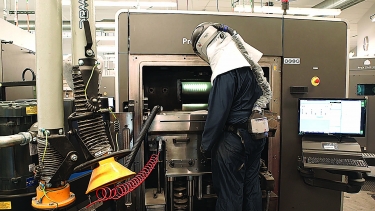
At 3D Systems’ Customer Innovation Center in Littleton, Colorado, application engineers work with customers to determine their unique needs. Image courtesy of 3D Systems
Similarly, the surfaces of 3D-printed metal parts are typically rough—similar to that of a sandcasting—and must be milled or turned if a smoother finish is specified. Holes are often reamed, bored or threaded. Features with tolerances in the neighborhood of ±0.005" or less must be machined, depending on the application. Heat treatment to remove thermally induced stress is also needed; plus, bead blasting to remove surface irregularities is common.
The takeaway is clear: Thanks to all this post-processing, never mind the higher material costs, a 3D-printed metal prototype is more expensive than the same part made of polymer. How much more is largely based on part size, its geometry and the alloy used, but several times the price is a reasonable guesstimate. However, as Cretella noted, cost comparisons like this are usually meaningless.
“It’s not so much a matter of metal versus polymer but rather a question of powder bed printing versus machining,” he said. “If the customer is looking for a prototype of a simple bracket or shaft, for example, then we would probably recommend using quick-turn CNC machining to produce it. If it’s a complex part geometry, however, something that requires multiple operations, or the customer is trying to reduce the number of components in an assembly—these are all areas where metal 3D printing shines, particularly in a prototype or low-volume production scenario.”
X Marks the Spot
Xometry Inc., Gaithersburg, Maryland, is another web-based provider of machined, fabricated, injection-molded and 3D-printed prototype and low-volume parts. Greg Paulsen, director of application engineering, agreed that the call for metal prototypes has grown exponentially over the past five years or so and suggested that machining remains a strong competitor, especially for parts that have not been designed with 3D printing in mind.
“There’s still a lot of learning to do when it comes to understanding what it is, what you get out of it and the nuances of the process itself,” he said. “With CNC machining, for example, the less metal I have to remove or the simpler the part design, the cheaper it is to make. A chunk of ½"-thick metal plate with a pair of holes in it, for instance, is about as easy as it comes, but that same part would be quite expensive to print.”
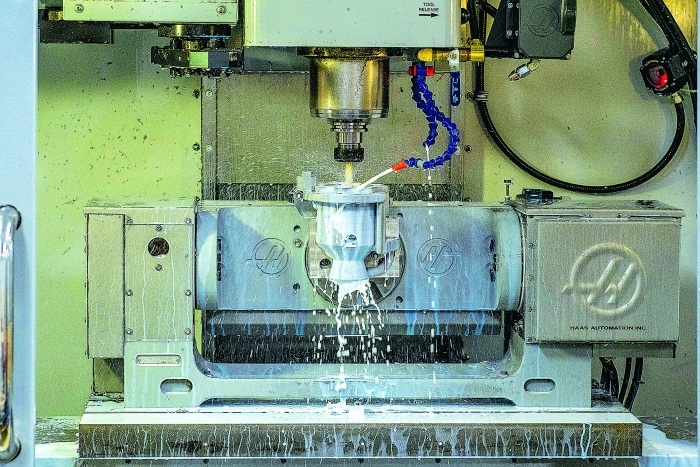
Machining the surface of a 3D-printed metal part at Protolabs. Image courtesy of Protolabs
Now take that same plate and hollow it out with a honeycomb pattern or fill it with a series of square holes, and almost any CNC machine shop would immediately no-quote such a job, whereas a shop with a metal powder bed printer thrives on such complex work. Undercuts and inaccessible recesses; thin walls; weird or intersecting angles; free-form “organic” shapes; meshes; helices; and bonelike structures are common fare for any 3D printer.
“That’s one of the first things I see when a new customer is reviewing whether DMLS is right for them,” Paulsen said about a common style of metal powder bed printing. “They’ll throw a $12 part at it that they’ve been making for years and are surprised when it costs $400 to print. Yes, you can build practically anything with a 3D printer, but unless the part is actually designed with 3D printing in mind, the results will probably be disappointing.”
So how do you know which parts—prototype or otherwise—are best for 3D printing? Every workpiece is different, but remember that metal powder is relatively expensive, as are the lasers used to fuse it. If a part is not “blocky” or monolithic, contains one or more of the complex features listed earlier or is difficult or even impossible to machine, it’s probably a good fit for AM.
Visiting an Old Friend
Not all metal printers are powder bed. A new breed of 3D-printing technology—one that shares many similarities with the decades-old MIM process—has entered the fray, and it promises to take 3D printing beyond prototype and low-volume production into automotive-level volumes.
Larry Lyons, vice president of product at Desktop Metal Inc., Burlington, Massachusetts, said his company took a two-pronged approach: one aimed at prototyping and the other at production volumes that laser metal powder bed printers can’t hope to reach.
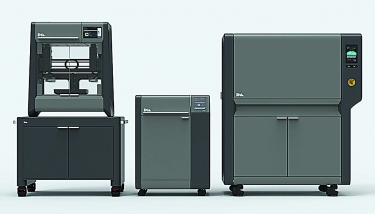
The Studio System eliminates lasers and loose powders often associated with metal 3D printing, making it safe to use at any facility. Image courtesy of Desktop Metal
“One of our first customers was Milwaukee Tool, who came to us for help with an auger bit that they’ve been producing for many years,” he said. “Using our Production System, we were able to take their existing 17-step manufacturing process and reduce it to just four steps, delivering a 15% cost savings on a product that sells at a rate of roughly 10 million units annually.”
The Production System works much like the company’s prototyping printer, known as the Studio System. As with powder bed machines, the Production System lays down individual layers of metal. But instead of using a laser to sinter them, a polymer binder is applied to hold them together until printing finishes. The Studio System, on the other hand, extrudes rods of metal powder mixed with polymer and a wax binder, similar to how an FDM-style printer works. In either case, the “green” workpiece is placed into a de-binding station before being sintered in a furnace. The result is a homogenous, fully dense metal part no different from one produced with the MIM process.
“Desktop Metal was founded in 2015 with the goal of trying to bring metal 3D printing into the mainstream,” Lyons said. “It’s this mission statement that led us to our two-pronged approach. We feel that the current laser-based metal printing technology has a number of limitations in terms of speed and cost that our systems avoid. There are some differences in the way that the Studio System and Production System print that may impact the part design, but otherwise the two are quite similar in terms of functionality. A clear path exists to take parts from prototype to full-scale production.”
Related Glossary Terms
- alloys
alloys
Substances having metallic properties and being composed of two or more chemical elements of which at least one is a metal.
- chuck
chuck
Workholding device that affixes to a mill, lathe or drill-press spindle. It holds a tool or workpiece by one end, allowing it to be rotated. May also be fitted to the machine table to hold a workpiece. Two or more adjustable jaws actually hold the tool or part. May be actuated manually, pneumatically, hydraulically or electrically. See collet.
- computer numerical control ( CNC)
computer numerical control ( CNC)
Microprocessor-based controller dedicated to a machine tool that permits the creation or modification of parts. Programmed numerical control activates the machine’s servos and spindle drives and controls the various machining operations. See DNC, direct numerical control; NC, numerical control.
- lapping compound( powder)
lapping compound( powder)
Light, abrasive material used for finishing a surface.
- sintering
sintering
Bonding of adjacent surfaces in a mass of particles by molecular or atomic attraction on heating at high temperatures below the melting temperature of any constituent in the material. Sintering strengthens and increases the density of a powder mass and recrystallizes powder metals.
- turning
turning
Workpiece is held in a chuck, mounted on a face plate or secured between centers and rotated while a cutting tool, normally a single-point tool, is fed into it along its periphery or across its end or face. Takes the form of straight turning (cutting along the periphery of the workpiece); taper turning (creating a taper); step turning (turning different-size diameters on the same work); chamfering (beveling an edge or shoulder); facing (cutting on an end); turning threads (usually external but can be internal); roughing (high-volume metal removal); and finishing (final light cuts). Performed on lathes, turning centers, chucking machines, automatic screw machines and similar machines.
Contributors
3D Systems Inc.
888-598-1438
www.3dsystems.com
Desktop Metal Inc.
978-224-1244
www.desktopmetal.com
Proto Labs Inc.
877-479-3680
www.protolabs.com
Xometry Inc.
240-252-1138
www.xometry.com


